Χρονοδιάγραμμα μεταλλάξεων
(μια ιστορική επισκόπηση με σημαντικές ημερομηνίες)
 If you have any other helpful information about mutations or if you are creator of new mutation, please contact us and we will complete this Timeline with info.You can also send us photos of your birds to put in to this Timeline and gallery.
If you have any other helpful information about mutations or if you are creator of new mutation, please contact us and we will complete this Timeline with info.You can also send us photos of your birds to put in to this Timeline and gallery.
Mutations Timeline
-
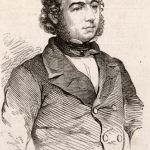
1838: first description by John Gould
1838 The first description of a Gouldian Finch has been made by John Gould on an ornithological Australia expedition.
-
1839: first scientific name (Poephile admirable)
1839, April The first scientific name was given from Jacques Bernard Hombron and Honroe Jacquinot. They named the Gouldian Finch “Poephile admirable”, after they found three specimens of Black-headed Gouldian Finches.
-
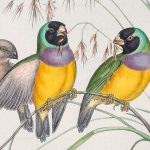
1841: Lady Gouldian Finch
1841 John Gould's wife Elizabeth died after an expedition to Australia. In honor of his wife, he calls the Gouldians “Lady Gouldian Finch”. She lithographed for the first time Gouldian Finches.
-
1844: Amadina gouldiae
1844 John Gould classifies the Gouldian Finch in the genus “Amadina gouldiae”, because he described the
Gouldian Finch first before Jacques Bernard Hombron and Honroe Jacquinot. That's why the classification was him allowed. -
1862: Chloebia
1862 Because of the unique appearance of the Gouldian Finch in the approximately 130 kinds comprehensive
family of Australian finches, Reichenbach classified the Gouldian Finch in the genus “Chloebia”. In this classification was only the species Gouldian Finch
represented. -

1876: first yellow-headed Gouldian
1876 The first yellow-headed Gouldian Finch was collected by W.G. Armit at Four Mile Creek, Dunrobin, near Georgetown, North Queensland.
-
1886: The first successful Australian breeder / Phoephila armitana
1886 The first successful Australian
breeder was Dr. E. P. Ramsay. He named the yellow-headed Gouldian Finches “Phoephila armitana”. -
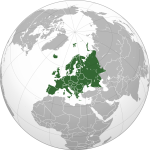
1887: first import to Europe / Spermestes gouldiae
1887 The first Red-headed and
Black-headed Gouldian Finches were imported to Europe. Another classification for the Gouldian Finches has been made by Dr. Karl Ruß: “Spermestes gouldiae”. -
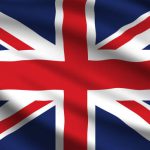
1888: The first successful breeder in England
1888 The first successful breeder in
England was Mr. Reginald Philips. -
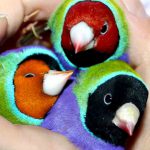
1891: three morphs of the same species.
1891 Mr. Reginald Phillips bred Gouldian Finches in England and proved that the three head colors of the
Gouldian Finches were from the same species. -
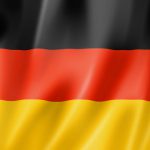
1896-1897 Gouldians in Germany show
1896-1897 The first Gouldian Finches were exhibited in Berlin/Germany
-

1899: first Melanistic
1899 Red-headed Females with Black feathering on their heads were considered to be Melanistic.
-

1915: First Yellow Headed in Europe
1915 Europe import Yellow-headed
Gouldian Finches. -

1930: First Lutino was wild caugh in Australia
1930 (around) Mr. Hans Catt in
Carlington, Sydney/ Australia had the first Lutinos, which were wild caught in the late 1930's. All Lutinos had bad eyesight. -
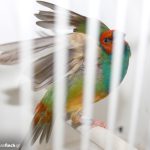
1936: The first Hybrid with Parrotfinch in Germany
1936 The first Hybrid “Blue Face
Parrot Finch x Gouldian Finch” was bred by K. Kleineidan in Riesa/Germany. He sold the hybrid to the Zoological Museum/ Copenhagen. -

1938: Gouldian with blue streaks in the chest and a greenish-yellow feathering
1938 Gouldian Finches with blue streaks in the chest and a greenish-yellow feathering were reported and bred by
the breeder Keston at the Foreign Bird Farm in United Kingdom. The report was not established. -
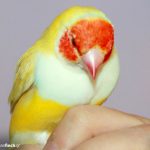
1940: Red-headed Lutinos in Australia
1940 (around) More Red-headed Lutinos were reported in Sydney/Australia. Also about white chest and yellow
body Gouldian Finches were reported in Australia. -

1941: First Australian Dilute
1941 The first “Australian dilute-back” Gouldian Finches were reported by E. Waite in Upper Paddington, Queensland/Australia.
-
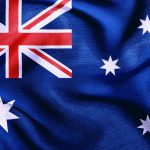
1945: More Dilute Gouldian in Aviary in Queensland
1945 More dilute-back Gouldian Finches were reportet in two aviaries in Queensland/Australia. The characteristics of the “Australian dilute-back” Gouldian’s are cream wings and back, the remainder of the plumage appears normal, the patch on upper throat and also the head band are white. This mutation inherited autosomal recessive and is only bred in Australia. The difference between the pastel-green, which was bred the first time in 1979 in Netherland is, that the Australien dilute-back mutation has a lighter green colour and the Pastel-green from the Netherland is co-dominant sex-linked.
-
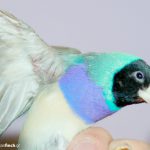
1946: First Blue Gouldian
1946 Report about Blue-backedGouldian Finches in Sydney/Austrarlia.
-
1949: Gouldian Finches with a green head
1949 Report about Gouldian Finches with a green head, bred by the breeder Leonard Webber. This report was never established.
-

1950: White breasted
1950 (around) Report that white-breasted Gouldians were bred by the breeder Fred Carew in Sydney/Australia and also in South Africa.
-

1950 (around) Lutino Red Head in Australia
1950 (around) Report about Lutinos in Campbelltown/Australia. The plumage of the Lutinos was butter yellow with red heads.
-
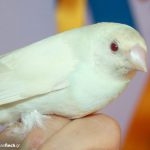
1950 (around) Albino in Australia
1950 (around) Report about Albinos in Australia
-
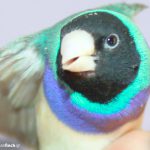
1950 (around) Blue gouldian in the wild
1950 (around) Report about blue-backed Gouldian Finches were caught from wild birds in Australia. This “Australian Blue” is teal-blue and autosomal recessive.
-

1953: Blue in Australia
1953 Report about blue-back Gouldians in Sydney/Australia.
-
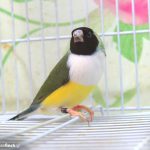
1954 White Breasted in South Australia
1954 Report about white-breasted Gouldians in South Australia.
-
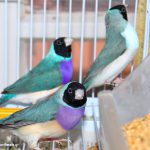
1955: First Blue successful breeding in Australia
1955 Blue-backed Gouldians were successful bred by Ray Murray in Sydney.
-
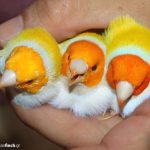
1957/58: three Lutinos were caught in the wild.
1957/58 Report that three Lutinos were caught in the wild.
-
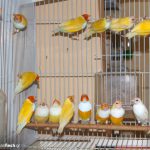
1958: 50 Lutino Gouldian in Australia
1958 In Australia was reported that 50 Lutino Gouldian Finches existed, but later all died. The Lutino mutation disappeared in captivity. 55 birdcatchers caught 27,000 Gouldian Finches near Kimberly/Australia. Not more than 400 survived.
-

1959: Gouldian with yellow wings, pale-green back, white breast and a brown mask
1959 Report that a Gouldian Finch with yellow wings, pale-green back, white breast and a brown mask was bred by the breeder H. R Gilbert in the United Kingdom. After the moulting the bird gotoverall white plumage. Though the report was not confirmed.
-

1960. 01. 01: Australia stop Animals & Birds export
1960. 01.01 A historical turning point: Australia imposed an export ban of all kind of animals, of course Gouldian Finches. This law is also valid for in captivity bred animals.
-
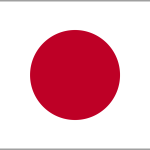
1960: Lutino Gouldians in Japan
1960 (around) Report about Lutino Gouldians in Japan.
-
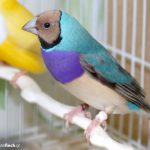
1960: teal-blue Gouldian caught from the wild in Australia.
1960 (around) Report about more blue-backed Gouldian Finches with a teal-blue colour were caught from the wild in Australia.
-
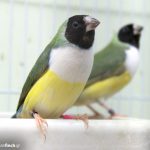
1962: White Breast in South Africa
1962 Report that white-breasted
Gouldian Finches were bred in South Africa -

1966: white breast, white wings, tangerine head, cream body Gouldian
1966 Report about a cream body Gouldian Finch with a white breast, white wings, a tangerine head, flecked
with grey, and pink legs. This report from Australia was not established. -
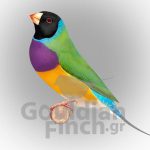
1967: Report about fallow red-eyed in Japan
1967 Report about fallow red-eyed Gouldians in Japan. The fallow mutation in Gouldians is autosomal recessive.
-
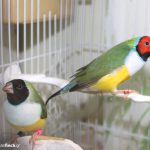
1967: White Breasted in Netherland
1967 Mr. F. Barnicoat, South Africa, bred the three head colours in the white-breasted Gouldians and published an articel about the white-breasted Gouldian Finches. Mr. F. Barnicoat exported white-breasted Gouldian Finches to Netherland.
-
1969: African White Breasted birds in Europe
1969 Mr. F. Barnicoat, South Africa,
exported white-breasted Gouldian Finches to England (breeder R. A. Eggington), France and Italy. -

1970: Blue Breasted Gouldian
1970 (around) Report about blue-breasted Gouldians in the USA, Europe, South Africa and Australia. At this time it was not proved that the appearance of the blue- breasted Gouldian Finches was a mutation. It was thought to be an over-melanization.
-
1970: White-breasted exported to England
1970 White-breasted Gouldians exported from South Africa to England (breeder Eric Cooper).
-

1973: Fawn Gouldian
1973 Two reports about fawn Gouldian
Finches (breeder Keith Thompson, Melbourne and L. Koenig, Ararat/Australia. They didn’t have pink eyes. The report was not established. Also another report about the appearance of fawn Gouldians in two aviaries in Melbourne was not established. -
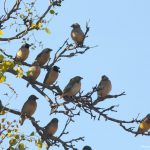
1974: Gouldian population in the wild reduced
1974 The Gouldian Finch population in the wild
reduced suddenly. -
1976: White Breasted in United Kingdom
1976 Report from the United Kingdom that 21 Breeders had white-breasted Gouldian Finches. Report about exports of white-breasted Gouldian Finches from South Africa and England to the USA.
-
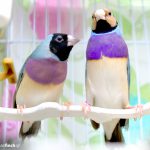
1977 The Australian Blue & European Blue
1977 The “Australian Blue” mutation and the “European Blue” mutation appeared the same time. The difference is that the “Australian Blue” has more green in the plumage at the back. Report about blue-backed Gouldians appeared in the Netherland. The report was established.
-

1977: White Breasted in USA
1977 USA imported white-breasted Gouldian Finches.
-
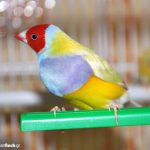
1978: Lilac Breasted in England
1978 Report about the lilac chest Gouldian Finch. An English breeder had been bred two white chested gouldian finches and got a male with the appearance of a lilac chest. For a long time this phenomenon has not been confirmed as a mutation and was also not popular.
-
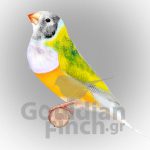
1987: Australian white-breasted yellow
1987: report about an “Australian white-breasted yellow Gouldian Finch” with a yellow head in Australia.
-
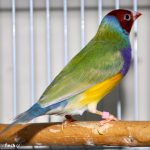
1979: first SF Pastel in Netherlands
1979 The SF pastel-green Gouldian Finch appears in Netherlands. First it was thought, that it was the same as the dilute-back Gouldian Finch mutation in Australia (a recessive mutation). Later it was proved that it was a sex-linked mutation and not the same as the dilute-back mutation in Australia. And another difference is, that the Australien dilute-back Mutation has a lighter green colour.
-

1980: Blue Breasted in USA
1980 (around) Report that blue-breasted Gouldians were bred by the breeder Herschel Frey in USA.
-
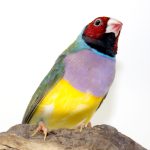
1982: WHite Breasted & Lilac Breasted in Australia
1982 Report that white-breasted and also lilac-breasted Gouldian Finches were bred by the breeder John Sammut in Sydney/Australia.
-

1982: Non sex-linked Lutino in Netherlands
1982: Report that a Lutino Gouldian Finch in the Netherland was offered for sale. The bird had a red head and was all yellow. Only one of this mutation existed. The Netherland bird magazin “Vriends” reports later (1991) that Lutinos with red and yellow heads had been established by the Netherland breeder G. Megens. This mutation had been established in Australia (around 1960) and was not sex-linked. G. Megens had crossed the Lutino with pastel to produce an Albino Gouldian Finch. This is probable the Fallow gene, the same appeared in Japan in the late 1960's.
-
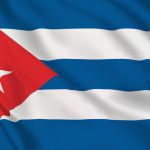
1983: Gouldians in Cuba
1983 The first Gouldian Finches were
exported from France to Cuba. -
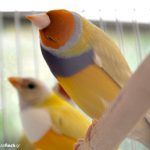
1984: Pastel Gouldians in the Netherland
1984 Report about Pastel Gouldians in the Netherland, which appeared in 1979. Price for each one: $1000.
-
1984 Yellow Headed, White breasted, Blue Breasted in USA
1984 Report that yellow-headed Gouldian Finches in the USA were firmly established in the USA.
1984 Report that white-breasted Gouldian Finches had been firmly established in the USA. The price is twice to three times higher than the normal. Report that lilac-breasted Gouldian Finches were available in small numbers in the USA and England.
1984 Report that blue-breasted Gouldian Finches were available in small numbers in the USA and Europe, with prices typically three or more times the cost of normal Gouldians.
-

1984: Special colors
1984 Reports about special colour appearance, inter alia: - red-breasted Gouldians in South Africa - black-breasted Gouldians in Germany - Gouldians with black back and wings - Gouldians with red between the breast and stomach.
-

1984: SF Pastel Blue in USA
1984 Report that the first SF Pastel blue Gouldian Finch appeared in USA. The bird was bred by the breeder Terry Dunham.
-
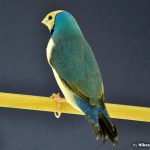
1985: Blue are Popular in USA
1985 Report about purple-breasted and also white-breasted blue back Gouldian Finches are becoming popular in the USA.
-
1985: Chloebia Gouldiae
1985 The species Gouldian Finch was classified in the genus “Chloebia Gouldiae”.
-

1985: More special colors
1985 Reports about more special colour appearance, inter alia: black-headed white-breasted Gouldian Finches with patchy turquoise blue colour among the green feathers.
-

1985: Pastel in Australia and Africa
1985 Report that SF Pastel back Gouldians were bred in South Africa and Australia. This mutation appeared first in the Netherland 1979 and is co-dominant sex- linked. (On the contrary: the Dilute Back in Australia is autosomal recessive).
-

1985: First pastel breeding in USA
1985 Report about the first Pastel Gouldian breeding in the USA by Terry Dunham.
-

1986: Pastel in Australia and other Australian mutations.
1986 (around) - 1987 Report that Australia has the “European Yellow/Pastel”, which is sex-linked like the European Pastel Green mutation and an Australian Pastel, which is autosomal recessive. Australia also has the “Australian dilute-back muation”, which is autosomal recessive and the “Australian white-breasted yellow muation, which is also autosomal recessive.
-

1986: Lilac Breasted in UK
1986 Report that several breeders in the United Kingdom were able to establish the lilac brest mutation.
-
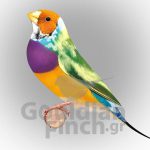
1986: First Pied in Australia
1986 Report that a red-headed pied Gouldian Finch was bred by Phil Thompson in Australia.
-
1986: Estrildidae
1986 The species Gouldian Finch was classified in the family of birds “Estrildidae”.
-
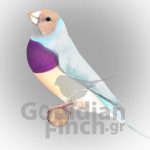
1987: First Pastel Blue (Silver) in USA
1987 Report that the first Pastel Blue (Silver) Gouldian Finch in the USA was bred by Mr. Terry Dunham.
-

1988: export from Venezuela to Cuba
1988 Report about export of Gouldians from Venezuela to Cuba.
-
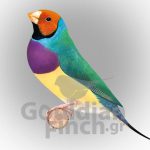
1990: Seagreen in Australia, Europe and USA.
1990 (around) Report about the existence of sea-green Gouldian Finches in Australia, Europe and USA.
-

1990: Interest in Genetics
1990 Report that a black-headed, blue-backed Gouldian Finch, bred by the breeder Mr. Robert Lynd, New Lambton/ Newcastle/ Australia, from green parents. The report was not established, because the bird died.
Report that Lutino Gouldian Finches were bred in Belgium.
Report that the “Australian yellow-pastel mutation” is sex-linked (alike the “European Pastel Green mutation”).
Report that the “Australian Dilute Back” is autosomal recessive.
Report that the “Australian White Breasted Yellow mutation” is autosomal recessive.
Report that the “Australian Pastel” is autosomal recessive.
Report that the blue-backed Gouldians were not firmly established in Australia (until 1995).
Report that the “Australian Blue” gene (teal-blue) is autosomal recessive.
Report that the “Australian blue-backed mutation” is darker blue than the “European Blue”, but also autosomal recessive.
-

1991: Seagreen in Australia
1991 Report that sea-green Gouldian Finches appeared in Australia.
-

1991: Lilac Breast in Australia
Report that a lilac-breasted Gouldian Finch appeared in Australia.
-
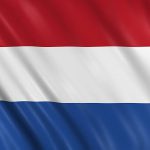
Pastel Blue (silver), Lutino, Albino in Natherlands
Report that a silver (pastel-blue) Gouldian Finch was the result of breeding dilute x blue Gouldian Finches.
Report that white-breasted Lutino Gouldian Finches with yellow heads and yellow bodies were bred by G. Megens/Netherlands.
Report that Albino Gouldian Finches was bred by G. Megens/Netherlands.
Report that white Gouldians with dark eyes appeared in the Netherlands.
-

1992: Lino Gouldians in Japan
1992 Lutino Gouldians in Belgium were sold to Japan.
-

1992 Gouldian species classified as endangered
1992 The species Gouldian Finch in the wild was classified as endangered.
-
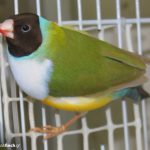
1993: first Cinnamon in Belgium
1993 Report that Cinnamon Gouldians were bred by Daniel Wildemeersch/ Belgium. Mr. Wildemeersch reported that this mutation is sex-linked, but had a high death rate.
-
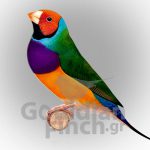
1994: Dark Factor in UK
1994 The English breeder Graham Tulk established Dark Factor Gouldians.
-

1994: Blue established in Australia
1994 Report that blue-backed (teal-blue) Gouldian Finches were established in Australia. Blue-backed Gouldians from Australia were first caught from wild birds and not similar to the blue-backed in Europe. They were last seen in 1970's, and then appeared again in 1990.
-

1995: Australian Variegated Blue
1995 (around) Report that a variegated Gouldian Finch from the cross of split blue Gouldian and a split Australian Yellow bird was bred, but the bird was of a weak genetic structure, no young were obtained. -
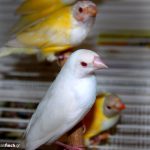
1999: Litino & Albino Gouldian in Japan
1999 Report that in Japan 10 breeder have Lutino and Albino Gouldians.
-

2002: first USA Pink Breasted Lutino
The USA Lutino was discovered in Kingsport, TN in 2002.
The White Breast and Lilac breast genes can be added to the USA Lutino. USA Lutinos have a Purple breast [Pink] , the Lilac Breast is White and the White Breast is White. -

2003: First BH Ino in USA
2003 Report that the the first
black-headed Lutino in the USA was bred by the breeder Cindy Godwin. -
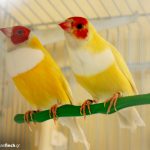
2005: Different Ino genes
2005 Report that different “Ino genes” exist. (the “Japanese fallow gene”, and a “Europe and USA sex-linked gene”). The “Japanese Ino Gouldian Finches” exists only in small numbers. The first Lutino Gouldian Finch (female) in USA was bred by the Delmar Gouldian Aviary. This Lutino female had a yellow head.
-

2005: Lilac Breast accepted as mutation
2005 Report that the lilac-breasted Gouldian Finches are bred worldwide and also accepted as a mutation: To the purple breast is the lilac breast autosomal recessive heritable. To the white breast is the breast chest autosomal dominant heritable.
-

2005: Lime in Australia
2005 Report about Lime Gouldians in Australia. This mutation is sex-linked recessive and alike the cinnamon mutation.
-

2005: Australian Dilute and Australian Yellow only in Australia
2005 Report that the “Australian dilute mutation” and the “Australian yellow white-breasted mutation” are only found in Australia. Both mutations are autosomal recessive.
-

2005: Cinnamon mutation not established in Europe
2005 Report that the Cinnamon mutation is not firmly established in Europe.
-

2005: Dark Factor in UK
2005 Dark Factor Gouldian Finches were reported in the United Kingdom. The “Dark Factor” is co-dominant.
-

2005: BH Ino in UK
2005 England reported Inos with black heads and white breasts.
-

2007 BH ino in Belgium
2007 A black-headed Lutino Gouldian Finch wins in a Belgian Exhibition.
-

2007: First RH ino in USA
2007 The first “USA red-headed Lutino” female was bred by the Delmar Gouldian Aviary.
-
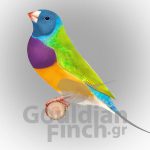
2009: first Blue Headed Gouldians from Cuba
22/09/2009: first Blue Headed Gouldians reported in Cuba by Breeder Juan Farrat Acanda. His Blue Headed gouldian left behind more than 60 descendants.
Blue head usually appear in SF Pastel Black Head males.
-
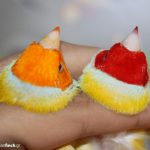
2010: First RH and YH ino males in USA
2010 Report that the first red-headed Lutino male were bred in the USA. Also the first yellow-headed Lutino male in the USA were bred. Both males were bred by the Delmar Gouldian Aviary.
-

2010: BH ino in Germany, Spain & Bahrain
2010 Report that Lutino Gouldian Finches with black heads, tan heads, brown heads and also white breasts were bred in Germany.
2010 Report that Gouldian Inos with black heads, tan heads, brown heads and white breasts and also red eyes were bred in Bahrain.
2010 Report that red-headed Gouldian Inos with a white breast were bred in Spain.
-
2010-2011: Gouldian Sosial Media Boom
2010-2011. The availability of the info on internet and photography has made it easier for breeders from all over the world to communicate. Clubs and groups for discussions in social networks are being created.
-
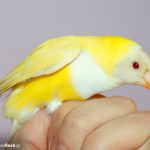
2011: First BH ino & Albino females in USA
2011 Report that the first yellow-headed and black-headed Albino females were bred by the Delmar Gouldian Aviary in the USA.
2011 Report that the first black-headed Lutino Gouldian Finches were bred in America by the Delmar Gouldian Aviary. Both birds were females.
-

2011: first RH ino in Germany
2011 Report that red-headed Gouldian Inos with a white breast were bred in Germany.
-
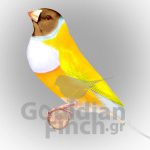
2011: Cuban Ino with Chocolate heads
2011 Report that “Cuban Inos” (originated from Spain) came to the USA. The “Cuban Inos” have black heads, tan heads and brown heads with a white breast, also red eyes and darkish yellow bodies. Probablythis was combination with Cinnamon mtation.
-
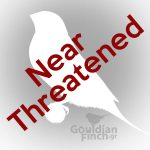
2011: Red List in category “Near Threatened”
2011 The IUCN Red List classified the Gouldian Finch in the category “Near Threatened”. This means the species Gouldian Finch is close to qualifying for or is likely to qualify for a threatened category in the near future.
-
2012: Blue ino with tan head in Israel
2012 Report about an Albino
Gouldian with tan head in Israel. -
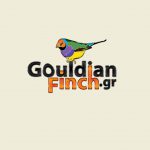
2012: GouldianFinch.gr was founded
2012 GouldianFinch.gr created
-
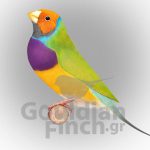
2014: New mutation Hungarian Dilute
New Mutation by Csaba Fekete. The first international presentation of Hungarian Dilute mutation was at the Serbian national ornithological championship in Sombor, in December 2014.
-
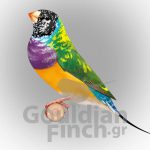
2015: first Vitiligo or Grizzle in Germany
2015: first Vitiligo or Grizzle in Germany by breeder Bernhard Größle
-

2016: Edge - Marble Backrd Yellow rump
Report in Facebook from 17.10.2016 about a new mutation in Gouldian Finches: The “Marbled-backed, yellow and white-rumped Gouldian Finch” by Manny De Freitas/ South Africa. Report from Facebook about a new mutation in South-Africa: The edge blue Gouldian Finch.
-

2016: Discussions about Pied
2016-2017 A lot of discussion about the currently occurring reports of “Pied Gouldian Finches”. A lot of pied Gouldian Finches seemed to be females. It is not yet determined whether
mutation or modification. -

2017-2018: First Blue Australian Dilute with Black Head
2017-2018 Some of the first black head purple breast Australian recessive dilute Blue appears by Kim Parker and Tony Ward
-
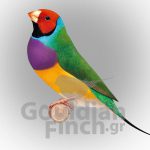
2018: Green Rump Gouldian
2018 very Green Rump Gouldian was discovered in Italy by Luigi Montini. Not established.
-

2018: Cinnamon Ino (Satinet) and Blue Satinet from Italy
2018: Report about Cinnamon Ino (Satinet) and Blue Satinet from Italy
-

2018: Cinnamon in Greece
2018 First Cinnamon imported in Greece from Italy
-

2018: Cinnamon Seagreen
2018: Cinnamon Seagreen by Jurre Corbee from Dutch
-

2018: First Pink Breasted Ino in Italy
2018: First European Pink Breasted Ino by Fabio Musumeci (Italy), enother one appear in 2022 by Alberto D'Andrea (Italy)
-
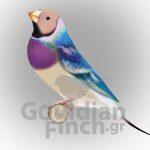
2018-2019: Blue Edge
2018-2019: Blue Edge were breed in South Africa
-
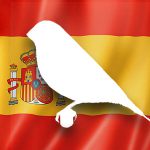
2018-2022: XXL Spain type of Gouldians
2018-2022: New type of heavy large sized Gouldians with wide round head, small triangular beak start promoted by Spain breeder Ivan Vera.
-
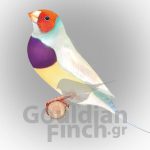
2019: Seagreen Pastel
2019: Seagreen Pastel by Spanish breeder Manuel Pan. -
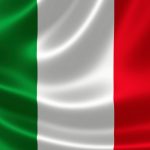
2019-2020: Ino, CInnamon, Blue, Pastel combinations in Italy
2019 - 2020 Combinations Blue Ino, Ino Cinnamon, Blue Ino Cinnamon, Ino Pastel, Blue Ino Pastel avalable in Italy by Nicola Casciello & Pilippo Pagliarini
-

2020: Hungarian Dilute accepted by COM
The Hungarian dilute mutation was accepted (22/01/2020) by the COM!
-
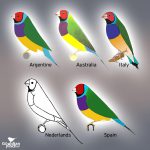
2020-2022: A lot of discusions about Show Standards, Body type & structure
We still don't have unique gouldian show standard in Europe. Some countries "push" for xxl zebra finch type goulians, other for natural type, other for something intermediate.
Australia remain without clear Show Standards but is closest to wild-type birds.
-
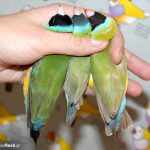
2022 - Discusions about rename Cinnamon/Hungarian Dilute/Pastel
There are numerous discussions in closed groups (Facebook and Whatsup) with expert breeders from different countries (Italy, Hungary, Spain, Portugal, Holland etc.) about mutations of Cinamon, Hungarian Diluted and Pastel. Test Breedings are being made and the structure of the feather and the effect of the mutation on melanosomes are also being studied. There are opinions about the incorrect name of the mutation Pastel and Cinnamon. Suggestions to rename Mutation Cinnamon to Hungarian Diluted, And possibly rename Mutation Pastel to may be Dilute or Pallid or something else. But still eeed a lot of testing because of give the same name to similar mutation of different species, it would be a big mistake... very different mutations may cause similar phenotype with quite different mechanisms.




